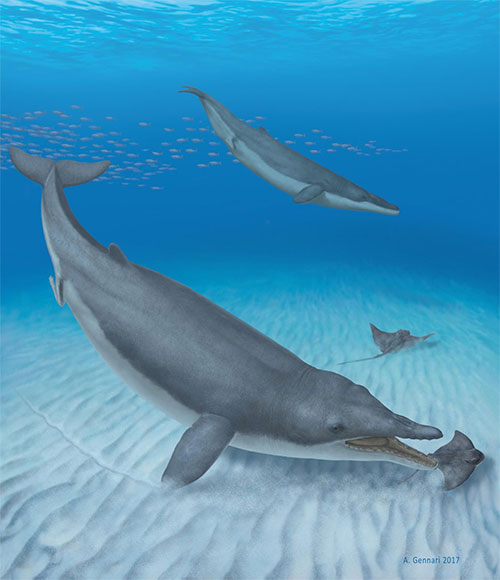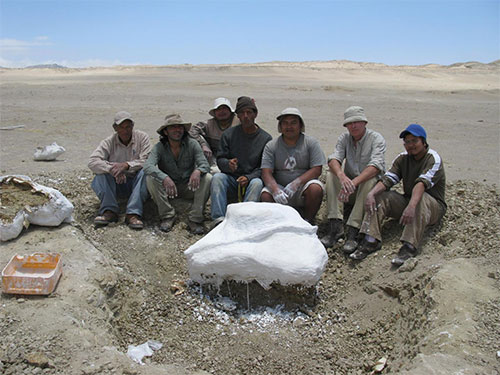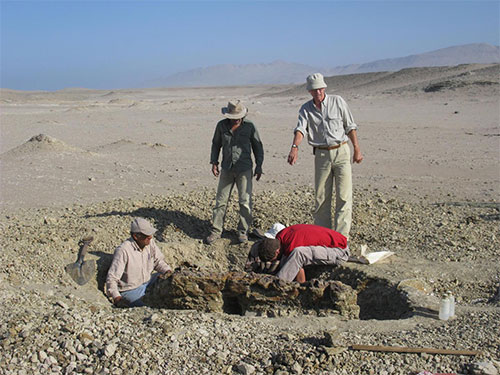
Baleen whales' ancestors were toothy suction feeders
May 11, 2017
This illustration shows two Mystacodon selenensis individuals diving down to catch eagle rays along the seafloor of a shallow cove off the coast of present-day Peru.
"This find by our Peruvian colleague Mario Urbina fills a major gap in the history of the group, and it provides clues about the ecology of early mysticetes," says paleontologist and study co-author Olivier Lambert of the Royal Belgian Institute of Natural Sciences. "For example, this early mysticete retains teeth, and from what we observed of its skull, we think that it displays an early specialization for suction feeding and maybe for bottom feeding." Mystacodon's teeth exhibit a pattern of wear that differs from more archaic whales, the basilosaurids. Many basilosaurids were probably active hunters, similar to modern orcas, with mouths that were suited for biting and attacking, but Mystacodon has a mouth more suited for sucking in smaller animals, leading the researchers to conclude that Mystacodon most likely represents an intermediate step between raptorial and filter feeding and between the ancient basilosaurids and modern mysticetes.
Members of the excavation team (from the Museo de Historia Natural, Lima and the Muséum National d'Histoire Naturelle, Paris) gathered around a plaster jacket surrounding part of the skeleton of Mystacodon selenensis at the Media Luna locality in the Pisco Basin, Peru.
Mystacodon bolsters that argument by displaying features of both basilosaurids and mysticetes. "It perfectly matches what we would have expected as an intermediary step between ancestral basilosaurids and more derived mysticetes,"says Lambert. "This nicely demonstrates the predictive power of the theory of evolution." Lambert and his colleagues think that Mystacodon may have started suction feeding in response to ecological changes. In illustrated reconstructions, Mystacodon is depicted diving down to the sea floor in a shallow cove, but based on this initial analysis, the researchers aren't sure to which extent Mystacodon was adapted to bottom feeding. "We will look inside the bone to see if we can find some changes that may be correlated with this specialized behavior," says Lambert. "Among marine mammals, when a slow-swimming animal is living close to the sea floor, generally the bone is much more compact, and this is something we want to test with these early mysticetes."
Members of the excavation team digging around the skeleton of Mystacodon selenensis at the Media Luna locality in the Pisco Basin, Peru.
"For a long time, our comprehension of whale evolutionary history was hampered by the fact that most paleontologists were searching for bones relatively close to home, in Europe and North America," Lambert says. "However, key steps in whales' evolution happened in areas now occupied by India, Pakistan, Peru, and even Antarctica." Lambert and his colleagues plan to return to the excavation site in Peru to see if they can find more whale fossils from different epochs. Note: This work was supported by the Muséum National d'Histoire Naturelle (Paris, France) and the Italian Ministero dell'Istruzione dell'Università e della Ricerca.
On the Web:
Source of News:
Representations of fact and opinions in comments posted are solely those of the individual posters and do not represent the opinions of Sitnews.
|
||


